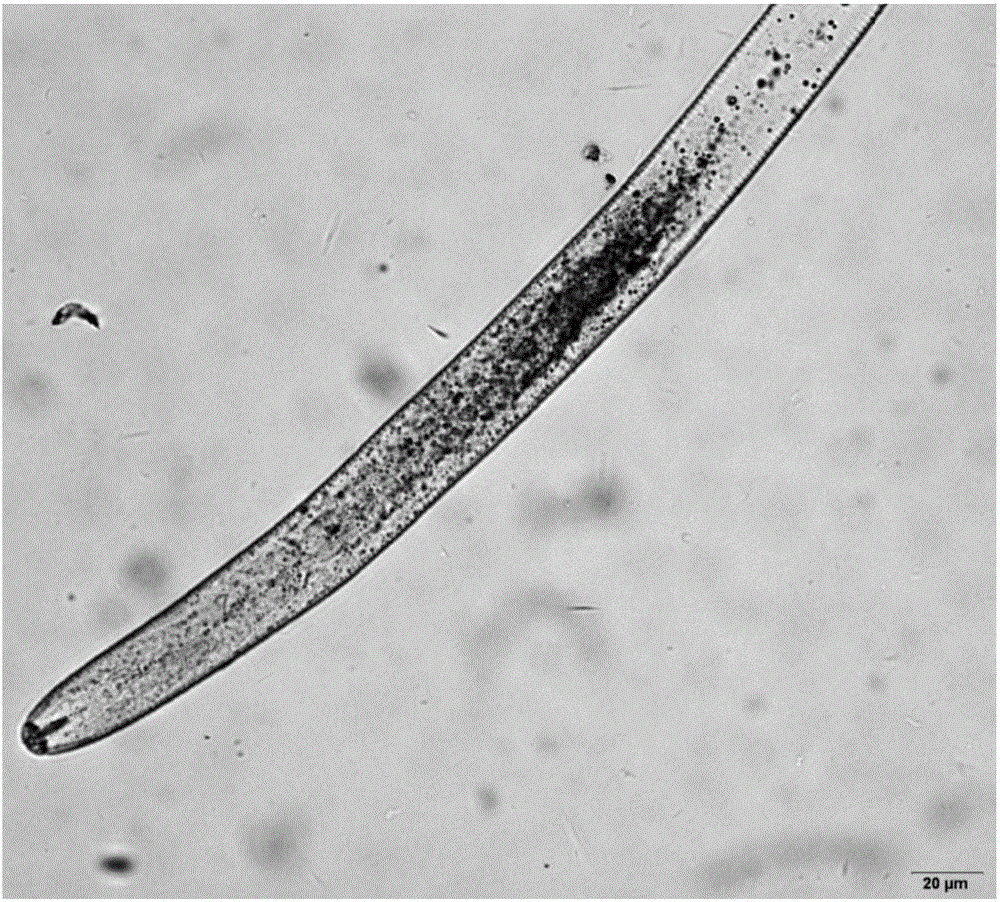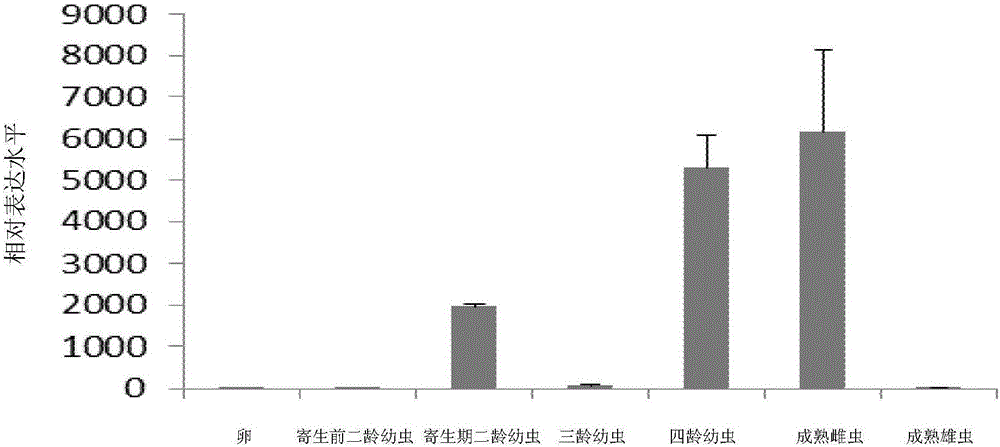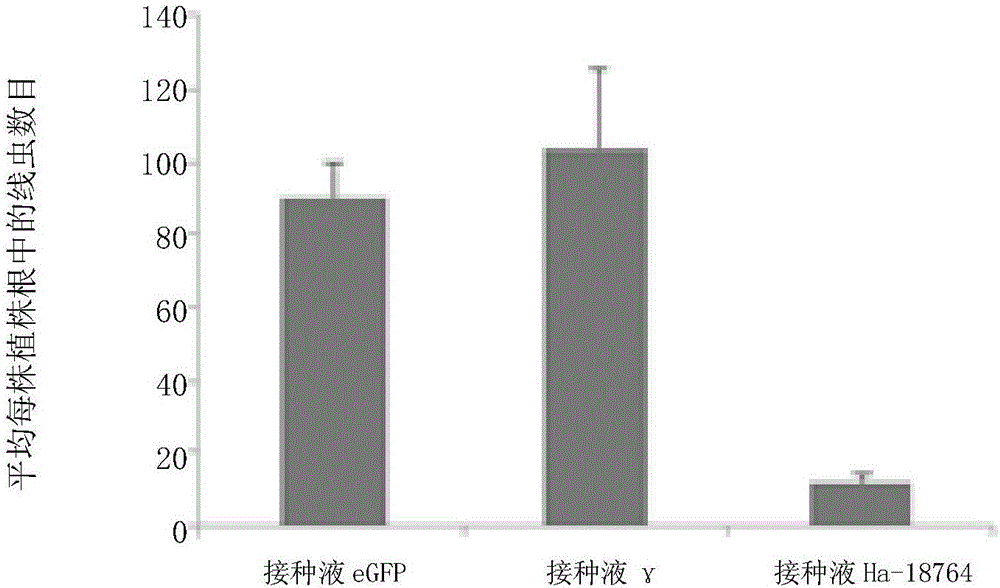Heterodera avenae derived Ha-18764 protein and coding gene and application thereof
A cyst nematode and coding technology, applied in application, nematicide, genetic engineering and other directions, can solve problems such as large side effects, insufficient research on the pathogenic mechanism of cereal cyst nematodes, and limited control effect.
- Summary
- Abstract
- Description
- Claims
- Application Information
AI Technical Summary
Problems solved by technology
Method used
Image
Examples
Embodiment 1
[0043] Example 1, Discovery of Ha-18764 protein and Ha-18764 gene
[0044] 1. Pick fresh single-grain cyst nematode cysts, freeze in liquid nitrogen, crush the sample with a tissue grinder, extract total RNA by magnetic bead method (QIAGEN), and reverse transcribe to obtain cDNA.
[0045] 2. Using cDNA as a template, PCR amplification was performed using a primer pair composed of Ha-18764F and Ha-18764R.
[0046] Ha-18764F: 5'-ATGGCTTCTTCAGCATCCTTTTC-3';
[0047] Ha-18764R: 5'-GAGTTTGTGTGATCCGCTTTTG-3'.
[0048] PCR amplification reaction system (25.00μL): 5×Q5Buffer 5.00μL, Q5High-Fidelity DNAPolymerase 0.25μL, Ha-18764F 1.25μL, Ha-18764R 1.25μL, template 1.00μL, use ddH 2 O make up.
[0049] PCR reaction program: 98°C for 30s; 35 cycles of 98°C for 10s, 55°C for 30s, 72°C for 40s; 72°C for 10min; 4°C for storage.
[0050] 3. Linearize the pGR107 vector (37°C water bath for 3-4 hours), recover the linearized plasmid, connect it with the PCR amplification product in step 2...
Embodiment 2
[0052] Embodiment 2, tissue localization of Ha-18764 gene
[0053] DIG High Prime DNA Labeling and Detection Starter Kit II (Roche) was used to conduct in situ hybridization experiments on the second instar larvae of the cereal cyst nematode.
[0054] 1. Using the cDNA of cereal cyst nematode as a template, a primer pair composed of Ha-18764-situ-S and Ha-18764-situ-A is used to amplify the target fragment (282bp) of the probe, and recover the target fragment.
[0055] Ha-18764-situ-S: 5'-AACACATTGTCTCGCTGAT-3';
[0056] Ha-18764-situ-A: 5'-AGTTGGTCCAGTCGTTGT-3'.
[0057] Reaction system (25μL): Phusion High-Fidelity DNA Polymerase 0.5μL, dNTPMixture (10mM each) 1.0μL, Ha-18764-situ-S 2.5μL, Ha-18764-situ-A 2.5μL, template 2μL, 5×Phusion HF Buffer 10μL,ddH 2 O make up.
[0058] Reaction conditions: 94°C for 4min; 35 cycles of 94°C for 30s, 52°C for 30s, 72°C for 1min; 72°C for 10min; 15°C for 5min.
[0059] 2. Asymmetric PCR is used to prepare sense probes or antisense pr...
Embodiment 3
[0065] Embodiment 3, the expression profile of Ha-18764 gene
[0066] Real-time fluorescence quantitative PCR was used to analyze the expression of Ha-18764 gene in each developmental stage of cereal cyst nematode (egg, pre-parasitic second-instar larvae, parasitic second-instar larvae, third-instar larvae, fourth-instar larvae, mature females and mature males) ) relative expression level. The GAPDH-1 gene was used as an internal reference. use Premix Ex Taq TM Kit (Takara), for Real time RT-PCR detection on ABI PRISM7000 fluorescent quantitative PCR instrument. The primer pair used to detect the Ha-18764 gene consisted of qHa-18764S and qHa-18764AS. The primer pair used to detect GAPDH-1 gene consisted of GAPDH-1S and GAPDH-1AS. The template is cDNA obtained by reverse transcription of the total RNA of cereal cyst nematodes at various developmental stages.
[0067] qHa-18764S (upstream primer): 5'-CCGCAGTGTCGGCTTTG-3';
[0068] qHa-18764AS (downstream primer): 5'-TTTG...
PUM
 Login to View More
Login to View More Abstract
Description
Claims
Application Information
 Login to View More
Login to View More - R&D
- Intellectual Property
- Life Sciences
- Materials
- Tech Scout
- Unparalleled Data Quality
- Higher Quality Content
- 60% Fewer Hallucinations
Browse by: Latest US Patents, China's latest patents, Technical Efficacy Thesaurus, Application Domain, Technology Topic, Popular Technical Reports.
© 2025 PatSnap. All rights reserved.Legal|Privacy policy|Modern Slavery Act Transparency Statement|Sitemap|About US| Contact US: help@patsnap.com



